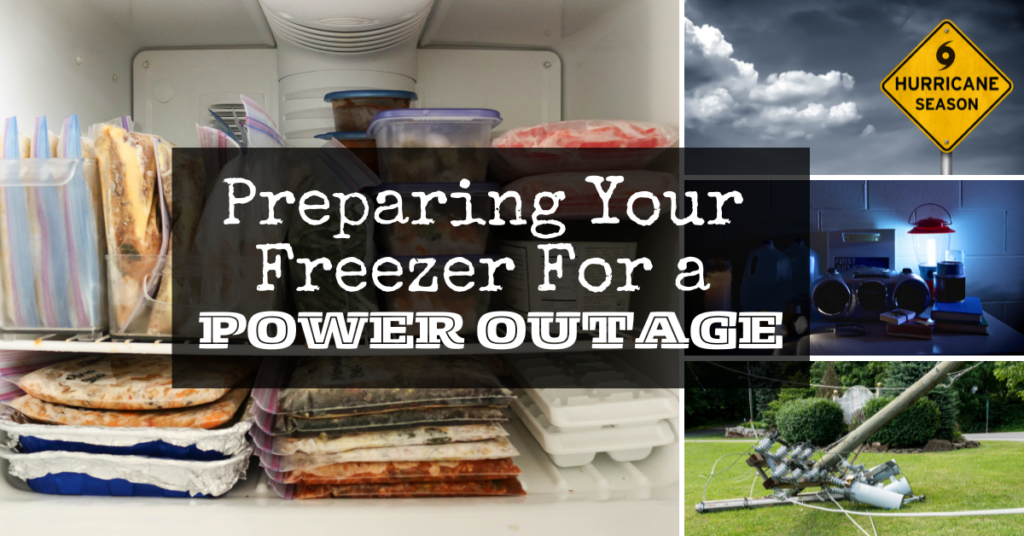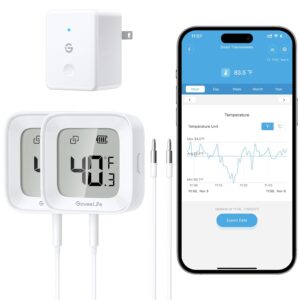
We’ve received numerous requests to cover freezer food safety in the event of a power outage due to severe weather like hurricanes, tornadoes, or blizzards. While we’ve touched on food preservation in general, it’s time we dive deeper into emergency situations and how you can prepare your freezer, maintain your freezer food supplies and/or salvage your food during a power outage..
Preparation:
- Invest in a Generator:
If you’re in a storm-prone area, consider investing in a generator. This can keep your freezer and refrigerator running periodically during an outage, helping to prevent food spoilage. - Transfer Food to a Safe Location:
Move frozen goods to a friend, family member, or neighbor’s house that still has power if possible. This is one of the best ways to ensure your food stays frozen. - Freeze Water in Bags, Containers Empty Milk Jugs:
Fill zippered freezer bags or containers ⅔ full with water (leaving space for expansion) and freeze them before the storm hits. These ice packs can surround your food, keeping it cold for longer in case of a power outage. More frozen items in your freezer help maintain a low temperature longer. - Stock Up on Dry Ice:
Locate a place to purchase dry ice ahead of time. Dry ice can extend your freezer’s cold temperature by an additional 1-2 days, offering extra protection if the power is out for an extended period. - Use Drip-Proof Containers for Foods:
For items that might leak when thawed (like meats or fruits), store them in containers to catch any drippings. Doing this before the power goes out means you’ll need to open the freezer less frequently, prolonging the life of your food. - Use the Quarter Test for Thawing:
Freeze a cup of water, place a quarter on top of the ice, and leave it in the freezer. If the ice thaws and refreezes, the quarter will sink, giving you a visual clue that your freezer experienced a thaw and food safety might be compromised.
When the Power Goes Out:
- Keep Freezer Doors Closed:
Avoid opening the freezer door unless absolutely necessary. Keeping it closed can preserve food for 24-48 hours, depending on how full it is. If you need frequent access to certain items, store them in a separate cooler with ice. - Use Dry Ice:
If you have access to dry ice, adding it to your freezer can extend the cooling period by an additional 1-2 days. Always handle dry ice with care, using gloves or tongs to avoid burns. - Monitor Freezer Temperature with a Thermometer:

Invest in an inexpensive indoor/outdoor thermometer and place the outdoor unit inside the freezer. This allows you to monitor the internal temperature without opening the freezer, which is especially useful when you have a generator and need to decide how often to run it. - Use the Quarter Test for Thawing:
If you prepare by freezing a cup of water and placing a quarter on top, when the ice thaws and refreezes, the quarter will sink, giving you a visual clue that your freezer experienced a thaw and food safety might be compromised.
After the Power is Restored:
- Check Food for Safety:
Once the power comes back, avoid holding the freezer open for long periods. Check for ice crystals on frozen items—if they’re still present, it’s safe to refreeze those foods. - Cook and Refreeze Thawed Meat:
If raw meat has thawed but stayed below 40°F and has been thawed for less than 2 hours, it’s safe to cook and refreeze it. - Handle Thawed Meals Safely:
Thawed freezer meals can be cooked if they haven’t been above 40°F for more than 2 hours. Don’t refreeze them unless they’ve been properly cooked. - Insurance Claims for Food Loss:
If you’re making a claim for storm damage through your homeowner’s insurance, remember that many policies also cover the cost of food lost during the event. This can be especially helpful if you’ve purchased bulk items like whole cows or chickens.
Stay Safe Above All
While salvaging freezer food is important, the safety of your family should always come first. If you’re ever in doubt about the safety of your food, remember the rule: when in doubt, throw it out. It’s better to avoid potential illness than risk eating spoiled food.
Bonus Tip from Our Community:
Many of our customers suggest using frozen water bottles or large ice packs to keep your freezer cold longer during outages. These low-cost, proactive measures can extend the life of your freezer’s contents and provide peace of mind during severe weather.
5 Comments
Join the discussionIf you save your plastic milk cartons and fill 2/3rds full of water you can freeze these and put in the bottom of your freezer till you need that space for food. It will help your freezer not to work so hard to keep cold normally and be prepared when the power goes out.
Great tip! Thanks for sharing!
Get a cheap indoor/outdoor thermometer and put the
outdoor unit in the freezer so you know the inside freezer
temp without opening the door. This is helpful if you have
a generator so you when and how long to run the generator.
Great idea, thanks for sharing!
Fill a plastic up with water and let freeze completely. Add a quarter on top and keep it the freezer. If your freezer thaws, the water in the cup will thaw, and you will have a visual exampleof an ice cube thawing, by where the quarter is located in the glass.